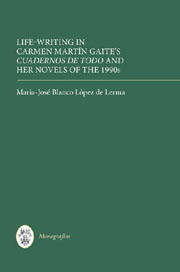Book contents
- Frontmatter
- Contents
- Dedication
- Acknowledgements
- Introduction
- 1 Letters, Diaries and Self-Reflective Writing
- 2 Cuadernos de todo: Carmen Martín Gaite's Diaries
- 3 Nubosidad variable: Letters and Diaries, Female Friendship through Writing
- 4 La Reina de las Nieves: a Personal Search through Diaries and Letters
- 5 Lo raro es vivir: Personal Reflections from Historical Research
- 6 Irse de casa: Life through the Cinematographic Lens, Writing One's Own Life-Script
- Conclusion
- Bibliography
- Index
1 - Letters, Diaries and Self-Reflective Writing
Published online by Cambridge University Press: 05 April 2013
- Frontmatter
- Contents
- Dedication
- Acknowledgements
- Introduction
- 1 Letters, Diaries and Self-Reflective Writing
- 2 Cuadernos de todo: Carmen Martín Gaite's Diaries
- 3 Nubosidad variable: Letters and Diaries, Female Friendship through Writing
- 4 La Reina de las Nieves: a Personal Search through Diaries and Letters
- 5 Lo raro es vivir: Personal Reflections from Historical Research
- 6 Irse de casa: Life through the Cinematographic Lens, Writing One's Own Life-Script
- Conclusion
- Bibliography
- Index
Summary
Letters and Diaries in Women's Writing
Letters and diaries have often been linked to women's writing. We see female characters in novels writing their diaries, composing letters to lovers or friends, or even imagining those possible letters they would like to send. Indeed, Ruth Perry comments: ‘Women seemed to have a special affinity for this personal one-to-one format.’ And Elizabeth Goldsmith refers to an observation made by Jean de la Bruyère in 1684: ‘Women, he reflects, have a special facility for epistolary expression, giving their letters a natural quality that men have to struggle to achieve.’
Women as writers are scarce until the Renaissance, as the written word was still the privilege of royalty, the upper class and convents. Writing about women as writers in the fifteenth and sixteenth centuries, María Milagros Rivera observes:
Los géneros literarios que cultivaron fueron la autobiografía (un género inaugurado en la lengua castellana por una mujer, Leonor López de Córdoba), la confesión mística (inaugurada por Teresa de Cartagena), el tratado político, la poesía, la novela sentimental en forma de la vida de Cristo, la novela de caballería y la carta o epístola.
According to Nora Catelli, writing remained a private practice for women: ‘Hasta mediados del siglo XVII, en el ámbito anglosajón, tanto en Inglaterra como en la Norteamérica puritana, sólo el diez por ciento del total de autobiografías, memorias y diarios publicados estaban firmados por mujeres, y lo publicado, casi en su totalidad, era de índole religiosa’.
- Type
- Chapter
- Information
- Publisher: Boydell & BrewerPrint publication year: 2013



